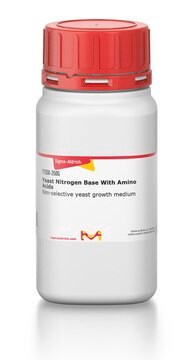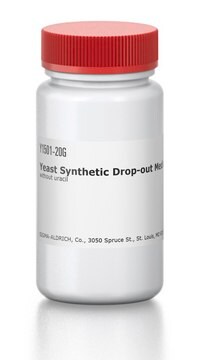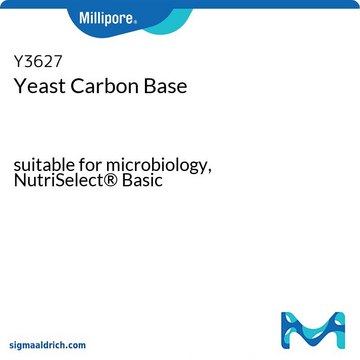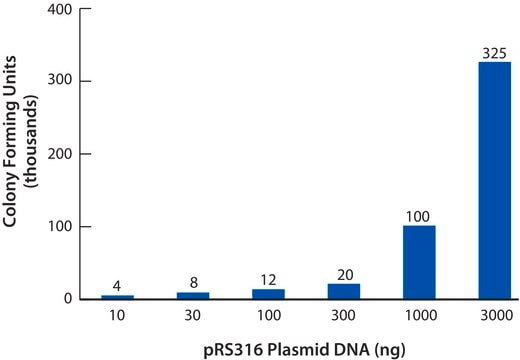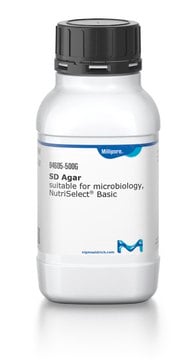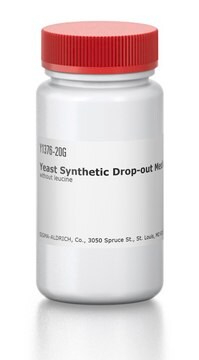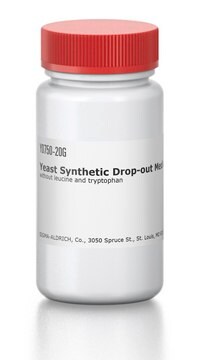Kluczowe dokumenty
Y1251
Yeast Nitrogen Base Without Amino Acids and Ammonium Sulfate
suitable for microbiology, NutriSelect® Basic
About This Item
Polecane produkty
sterylność
non-sterile
Formularz
powder
opakowanie
poly bottle of 1 kg
poly bottle of 500 g
producent / nazwa handlowa
NutriSelect® Basic
rozpuszczalność
water: soluble 67 mg/mL
Zastosowanie
clinical testing
food and beverages
life science and biopharma
microbiology
przydatność
Candida spp.
Pichia spp.
Saccharomyces spp.
Zygosaccharomyces spp.
molds
yeasts
Opis ogólny
Zastosowanie
Komponenty
Biotin, 2 μg/L
Calcium pantothenate, 400 μg/L
Folic acid, 2 μg/L
Niacin, 400 μg/L
p-Aminobenzoic acid, 200 μg/L
Pyridoxine HCl, 400 μg/L
Riboflavin, 200 μg/L
Thiamine HCl, 400 μg/L
Inositol, 2 mg/L
Boric acid, 500 μg/L
Copper sulfate, 40 μg/L
Potassium iodide, 100 μg/L
Ferric chloride, 200 μg/L
Manganese sulfate, 400 μg/L
Sodium molybdate, 200 μg/L
Zinc sulfate, 400 μg/L
Potassium phosphate monobasic, 1 g/L
Magnesium sulfate, 0.5 g/L
Sodium chloride, 0.1 g/L
Calcium chloride, 0.1 g/L
Uwaga dotycząca przygotowania
- Prepare a 10× stock solution by suspending 1.7 g of yeast nitrogen base without amino acids and ammonium sulfate in 100 ml of cold distilled water. Include desired nitrogen and carbon sources.
- Warm if necessary to solubilize and sterilize by filtration.
- Store 10× stock solution at 2-8°C. To use, dilute 1:10 with sterile distilled water under aspetic conditions.
Informacje prawne
Oświadczenie o zrzeczeniu się odpowiedzialności
Tylko elementy zestawu
- KH2PO4 1 g/L
- MgSO4 .5 g/L
- NaCl .1 g/L
- CaCl2 .1 g/L
- Inositol 2 mg/L
Kod klasy składowania
11 - Combustible Solids
Klasa zagrożenia wodnego (WGK)
WGK 3
Temperatura zapłonu (°F)
Not applicable
Temperatura zapłonu (°C)
Not applicable
Środki ochrony indywidualnej
Eyeshields, Gloves, type N95 (US)
Wybierz jedną z najnowszych wersji:
Masz już ten produkt?
Dokumenty związane z niedawno zakupionymi produktami zostały zamieszczone w Bibliotece dokumentów.
Klienci oglądali również te produkty
Produkty
Tradycyjne metody opierają się na morfologii, metodach barwienia, reakcjach enzymatycznych (metabolizm) i różnych mediach.
Traditional methods are based morphology, staining methods, enzyme reactions (metabolism) and diverse media.
Protokoły
Techniki hodowli drożdży: Systemy modelowe do badań eukariotycznych z płynnymi pożywkami lub wzrostem na płytkach agarowych.
Nasz zespół naukowców ma doświadczenie we wszystkich obszarach badań, w tym w naukach przyrodniczych, materiałoznawstwie, syntezie chemicznej, chromatografii, analityce i wielu innych dziedzinach.
Skontaktuj się z zespołem ds. pomocy technicznej
